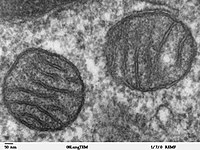
Photo from wikipedia
Calcium ions (Ca2+) act as secondary messengers in a plethora of cellular processes and play crucial role in organelle function and homeostasis. The average resting concentration of Ca2+ is nearly… Click to show full abstract
Calcium ions (Ca2+) act as secondary messengers in a plethora of cellular processes and play crucial role in organelle function and homeostasis. The average resting concentration of Ca2+ is nearly 100 nM and in certain cells it can reach up to 1 µM. The high range of Ca2+ concentration across the plasma membrane and intracellular Ca2+ stores demands a well-coordinated maintenance of free Ca2+ via influx, efflux, buffering and storage. Endoplasmic Reticulum and Mitochondria dependent on Ca2+ for their function and also serve as major intracellular Ca2+ stores. The ER-mitochondria interplay helps in orchestrating cellular calcium homeostasis to avoid any detrimental effect resulting from Ca2+ overload or depletion. Since it plays a central role in many biological processes it is an essential component of the virus-host interactions. The large gradient across membranes enables the viruses to easily modulate this buffered environment to meet their needs. Viruses exploit Ca2+ signaling to establish productive infection and evade the host immune defenses. In this review we will detail the interplay between the viruses and cellular & ER-mitochondrial calcium signaling and attempt to detail the significance of these events on viral life cycle and disease pathogenesis.
Journal Title: Mitochondrion
Year Published: 2021
Link to full text (if available)
Share on Social Media: Sign Up to like & get
recommendations!